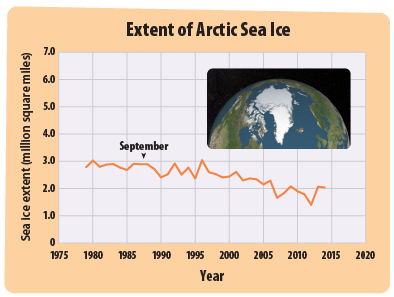Shrinking Sea Ice
 The Arctic Ocean around the North Pole is so cold that it is usually covered with ice. In the winter, the area covered by ice gets bigger, and in the summer it gets smaller. If the air and water are warmer than usual, Arctic sea ice will melt more than usual during the summer.
The Arctic Ocean around the North Pole is so cold that it is usually covered with ice. In the winter, the area covered by ice gets bigger, and in the summer it gets smaller. If the air and water are warmer than usual, Arctic sea ice will melt more than usual during the summer.
What's happening now?

The number of square miles covered by sea ice in the Arctic Ocean has been decreasing. This graph shows data from September of each year, which is when the amount of ice is usually the smallest. Source: EPA's Climate Change Indicators (2016).
The amount of summer ice in the Arctic Ocean in recent years was the smallest it's been since scientists started using satellites to measure the area covered by ice back in the 1970s. The ice is also getting thinner.
What will happen in the future?
Overall, Arctic sea ice will continue to shrink in the coming decades. However, the amount of sea ice may vary from year to year depending on factors such as local temperatures, wind patterns, and ocean currents.
Why does it matter?
Many animals depend on sea ice for their homes and hunting grounds, and native people in the Arctic need these animals as a source of food. In addition, ice and snow reflect a lot of sunlight back out to space and help keep the planet from getting too warm. If there's less ice, the Earth will absorb more energy from the sun and get even warmer. This is an example of a positive feedback loop, which happens when warming causes changes that lead to even more warming.
Check out the effects of shrinking sea ice on plants, animals, and ecosystems.
Learn more about melting sea ice by going on an expedition to the Arctic!